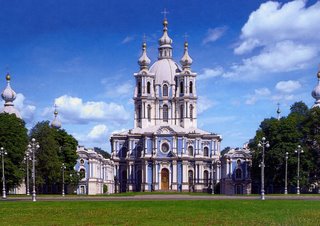Part 1: Architecture
In July I was in Saint Petersburg, Russia (also spending some time in Tallinn, Estonia by the Baltic Sea). While I do have a few wacky experiences and anecdotes that I could tell, I just want to write a series of posts about the art adventures that I had in that city.
One of the first things noticed in Saint Petersburg is the huge amount of Baroque architecture in the city center. I have never been much of a fan of Baroque architecture as my experience with it has generally left me with a sense of decadent and crumbling colonial empires and frankly I find cherubs to be disturbing, but this was the first city that I have been in that sprung up during a time when the Baroque aesthetic was dominant. Peter the Great moved the capital to Sankt-Petersburg when the Russia of the czars was at its apex in wealth, his goal not only to build a great port city on the Baltic Sea for greater commercial access to the west but also to literally impress his royal peers of western Europe, specifically in France, Holland, and Prussia with the grandeur of his architectural project. Designed by invited German architects, the city was built on a big swamp, and giant granite blocks had to be dropped into the bogs to hold up the foundations of the city, this required a ban on stone construction in the rest of Russia for about sixty years and by some estimates as many as 30,000 serfs died in the construction effort.

Among the many canals of the city, the density of Baroque styled buildings, palaces, and orthodox churches with the characteristic onion towers gives you much more of a sense of what the point of all the cherubs, flower like moulding, and candy coloured paint was (much of which has been recently restored). Something which I never understood very well in its manifestations in Spain or France which were usually stuck on top of an already impressive Gothic structure with cheaper materials and less sound construction techniques. The interiors are an exercise in visual excess in which every surface is covered in decoration while the exteriors try to continually draw your eye to sweeping architectural details on otherwise rather smooth buildings. You begin to be able to imagine the characters of War and Peace wandering between gossipy galas in their gigantic dresses and ornate Napoleonic military uniforms surrounded by frivolous Rococo paintings.

The city is also famous for its Neoclassical architectural achievements but I found those, while individually impressive, to be scattered throughout the city and the 19th century was more a time of internal political upheaval in Russia than Empire building glory projects.
In July I was in Saint Petersburg, Russia (also spending some time in Tallinn, Estonia by the Baltic Sea). While I do have a few wacky experiences and anecdotes that I could tell, I just want to write a series of posts about the art adventures that I had in that city.
One of the first things noticed in Saint Petersburg is the huge amount of Baroque architecture in the city center. I have never been much of a fan of Baroque architecture as my experience with it has generally left me with a sense of decadent and crumbling colonial empires and frankly I find cherubs to be disturbing, but this was the first city that I have been in that sprung up during a time when the Baroque aesthetic was dominant. Peter the Great moved the capital to Sankt-Petersburg when the Russia of the czars was at its apex in wealth, his goal not only to build a great port city on the Baltic Sea for greater commercial access to the west but also to literally impress his royal peers of western Europe, specifically in France, Holland, and Prussia with the grandeur of his architectural project. Designed by invited German architects, the city was built on a big swamp, and giant granite blocks had to be dropped into the bogs to hold up the foundations of the city, this required a ban on stone construction in the rest of Russia for about sixty years and by some estimates as many as 30,000 serfs died in the construction effort.

Among the many canals of the city, the density of Baroque styled buildings, palaces, and orthodox churches with the characteristic onion towers gives you much more of a sense of what the point of all the cherubs, flower like moulding, and candy coloured paint was (much of which has been recently restored). Something which I never understood very well in its manifestations in Spain or France which were usually stuck on top of an already impressive Gothic structure with cheaper materials and less sound construction techniques. The interiors are an exercise in visual excess in which every surface is covered in decoration while the exteriors try to continually draw your eye to sweeping architectural details on otherwise rather smooth buildings. You begin to be able to imagine the characters of War and Peace wandering between gossipy galas in their gigantic dresses and ornate Napoleonic military uniforms surrounded by frivolous Rococo paintings.

The city is also famous for its Neoclassical architectural achievements but I found those, while individually impressive, to be scattered throughout the city and the 19th century was more a time of internal political upheaval in Russia than Empire building glory projects.













